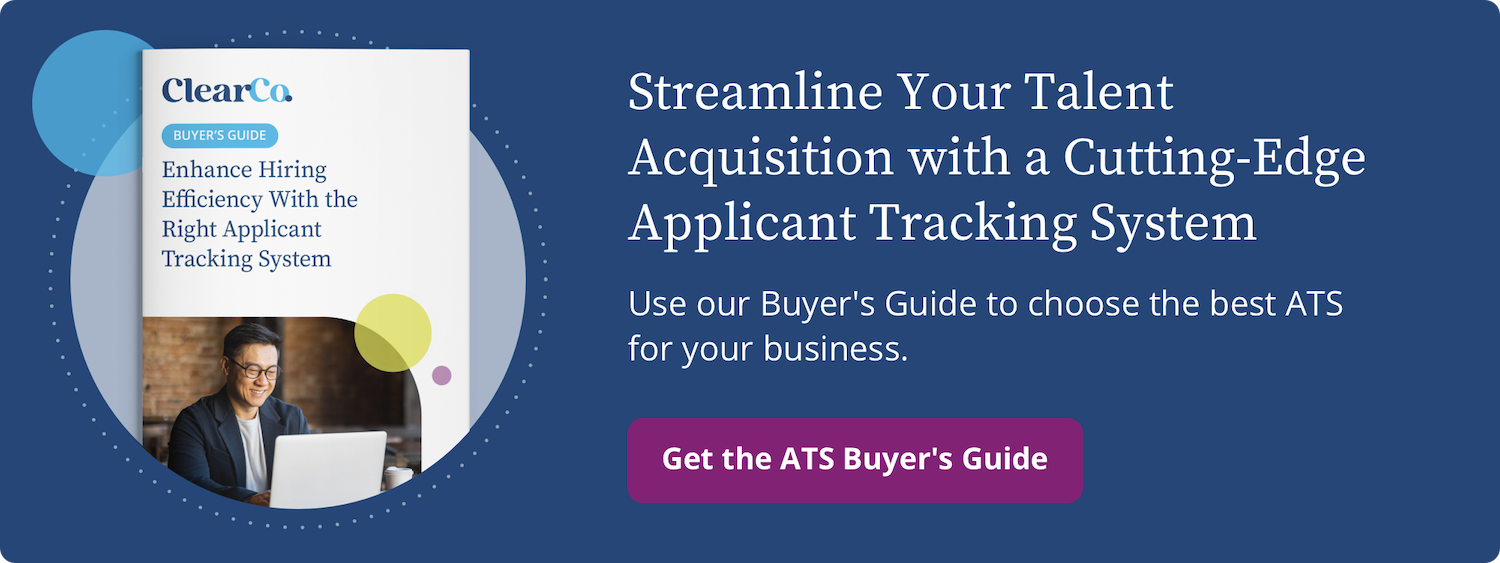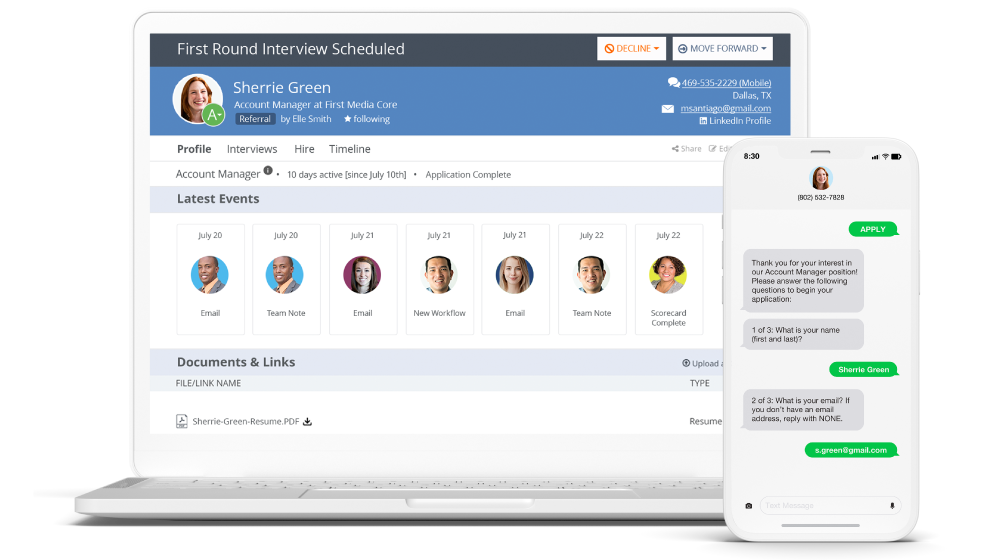Even with the best talent acquisition software and rigorous recruitment management systems, you might occasionally make a bad hire. If it happens to you, it's important to dig into why. Bad new hires cost your human resources team valuable time and money.
Keep reading for more on the impact of hiring mistakes and how you can address them.
61% of employers have settled for an employee who wasn’t a great match. If you're one of them, get 5 expert tips for handling bad hires:The Cost of Bad Hiring Decisions
Correcting a bad hiring decision comes at a substantial cost. Data from the U.S. Department of Labor estimates the cost of bad hires to be at least 30% of the employee's annual salary. The cost of additional recruitment activities and lost revenue because of poor client service could prove even more expensive in some industries.
Bad hires also affect employee morale and productivity, especially if others have to take on extra tasks to compensate for the underperforming employee. Addressing a bad hire takes a similar toll. Identifying poor performance, implementing an improvement plan, and ultimately terminating and replacing the person can all divert energy away from core business goals. Just one bad hire can cost the company valuable time — an average of 16 weeks — spent on determining they’re a bad fit and replacing them.
Although you do your best to notice any red flags during the interview process, there will inevitably be times when your hiring team gets it wrong. Here’s what to do when your qualified candidate turns out to be the wrong fit.
5 Tips for Handling Bad Hires
You're not alone if you've recently made a regrettable hiring decision. 61% of employers say they’ve settled for an employee who wasn’t a great match, with two-thirds of workers saying they've accepted a job and later realized it wasn't right for them.
The following tips can help you avoid bad hires and mitigate the cost of hiring the wrong person.
1. Use onboarding as a probation period.
Getting an accurate picture of whether a candidate is suitable for your organization can be challenging during the recruitment process. Treat your onboarding program, or some portion of it, as a probationary period to ensure new hires are right for the role. You can ask hiring managers to assess new team members against the job requirements and set them up to do their best.
Be upfront about how long onboarding will last and what to expect when it’s completed. You're free to determine the probation length to suit your business needs. The longer the probation period, the more time you have to evaluate skills such as leadership and relationship building. However, remember that excessive probation periods are often offputting, while overly short onboarding processes may not give you enough time to assess your recent hires.
As a rule of thumb, a 30-day probation period is adequate for most entry-level roles, though you might need up to 60 days if there is significant training as part of the onboarding process. 90-day probation periods are common for more experienced roles requiring broad skill sets.
Onboarding is most effective when new hires understand your expectations. Therefore, you should hold regular meetings to provide support, clarify queries, and deliver constructive feedback. This will also give new hires the best chance of completing their onboarding plan and probationary period successfully.
Even the best #TalentAcquisition teams make a bad hire every now and then. Learn how to handle this tricky situation with 5 expert tips:2. Determine why the new employee isn't meeting expectations.
If your new employee isn't meeting expectations at the end of their probation period, consider why this may be.
Instead of immediately assuming that their work ethic is poor, ask yourself if any common reasons for underperformance could be addressed by their onboarding program:
- Lack of training
- Unclear expectations
- Misunderstanding company policies and standards
- Inadequate tools or resources
- Excessive workload
- Lack of motivation
- Interpersonal problems
- Stressful working environment
Examining the reasons for underperformance can help you put measures in place to support new employees. For example, investing in additional resources or training opportunities may help new hires develop the skills they need.
Avoid Bad Hires With Great Interviews
You can avoid hiring the wrong candidates by asking excellent interview questions:
- Can you explain how you would tackle a relevant work-related problem step by step?
- How do you prioritize and organize your work when you have varying deadlines?
- Tell me about something you failed at and what you learned from it.
3. Talk to the employee.
Talking to the employee can help you identify reasons for poor performance and assess their potential for change. While these conversations can feel uncomfortable, starting them early minimizes the impact of a bad hire on your team. It also gives the employee the chance to address your concerns, turning a bad hire into a valuable team member.
Clearly explain how your employee is underperforming and what they need to do to meet company expectations. It's essential to be receptive and listen to your employee's thoughts on what would help them succeed. They know themselves best and may suggest improvements that increase their chances of success and benefit the entire organization.
During the meeting, create a clear, actionable improvement plan and agree on timeframes and review procedures. Outline what support your employee can expect and commit to following through.
Helping an enthusiastic, driven employee to overcome performance issues is often worthwhile. Responsibility and integrity are high-demand job traits, so it's important not to give up on an employee too quickly if they have a strong work ethic. Not to mention, businesses that invest in their employees create more motivated, committed workforces.
4. Reassign the employee.
Reassigning an underperforming employee to a new role could be a positive (and economical) solution in some circumstances. Generally, reassignment is a good option if your employee lacks crucial skills but has a great work ethic and fits well within your company culture. Depending on the extent of the issue, it could also be worth offering additional training and support to help them acquire the skills they need for the new role.
Reassignment only works if you have an existing vacancy that suits your employee's skills and traits. In this situation, offering reassignment to the employee can benefit your organization because you'll already have in-depth knowledge of the person's strengths and weaknesses — and you know they're a cultural fit. It also allows you to avoid the cost of externally recruiting for the new role and potentially making another bad hire.
Role reassignment can be a stressful experience for employees, and respectfully managing the process protects their well-being and prevents morale issues. Involving your HR department in meetings can help you handle any problems your employee raises when discussing a potential reassignment. Emphasize the qualities and skills that make your employee a good fit for the role, and ensure they understand their new responsibilities to ensure a successful transition.
5. Terminate the employee.
If reassignment isn't an option and the employee isn't showing signs of improvement, you may have to resort to terminating their employment. Following best practices for firing an employee is essential because it protects your company against potential legal action.
For example, you should determine if there are exceptions to at-will hiring in your state. A lawyer with expertise in employment law can advise you on how best to handle the termination process and reduce the risk of litigation.
The U.S. Chamber of Commerce recommends following these steps to comply with employment law when terminating an employee:
- Review your termination policy to ensure your decision complies with your workplace procedures and follow the agreed process closely.
- Document and store details of your employee's performance issues or policy violations.
- Collect evidence to support your decision.
- Provide information about unemployment benefits and insurance transportability.
- Prepare your employee's final paycheck.
What to remember when letting an employee go
How you break the news to the employee and the rest of your team can impact your business. Prepare for the termination meeting by ensuring you have all the necessary paperwork and details of the employee's reference arrangements and severance pay on hand. Hold the meeting in a private space where you won't be disturbed to respect the employee's privacy and dignity.
Keep your explanation factual and explain the grounds for termination clearly so the employee understands why you made the decision to let them go. Maintain a professional, respectful tone and be prepared for a negative response.
Some employees may try to persuade you to change your mind or alter the terms of their termination. Allow the employee to speak their mind and respond with patience and empathy. However, remember you've decided to terminate their employment for a reason, so don't let yourself be swayed by the heat of the moment.
Terminations can make your other employees feel insecure in their jobs. While avoiding discussing a colleague's departure with your team can be tempting, a lack of information may encourage speculation about further job losses.
Respect both your former employee's privacy and your team's well-being by telling your team they have left and outlining how you plan to address their responsibilities while you find their replacement.
The Bottom Line
Creating rigorous hiring processes is the most effective way to avoid hiring bad employees. Clarifying what skills and attributes you're looking for makes it easier to spot the most promising candidates. Once you've determined your requirements and written a clear job description, consider ways to streamline your hiring process.
One of the best ways of doing this is to leverage applicant tracking systems (ATS). These allow you to streamline the hiring process by screening large volumes of resumes against your ideal employee's profile. These tools streamline your recruitment pipeline, enabling you to focus on assessing and interviewing the best talent.
Are you looking for the right ATS to help you avoid bad hires? Get ClearCompany’s ATS Buyer’s Guide for a how-to on choosing the best ATS for your organization.



